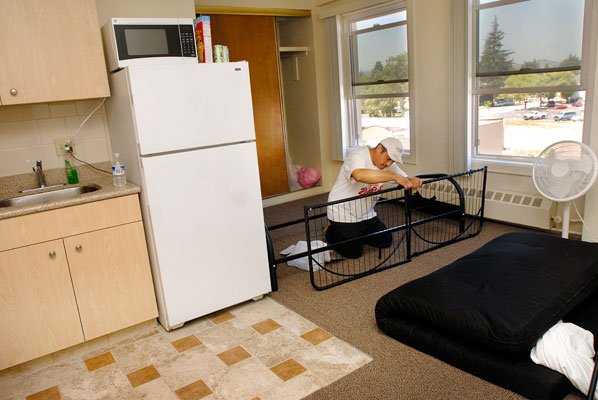For Graciela Hilliard, a warm shower and a soft place to lay her
head are some of life’s most luxurious indulgences.
For Graciela Hilliard, a warm shower and a soft place to lay her head are some of life’s most luxurious indulgences.
The quick-to-smile, formerly homeless woman used to rouse herself from a broken doze in Las Animas Veterans Park every morning and walk a few blocks south in the pre-dawn hours to lock herself in the Miller Park ladies’ room and steal a few minutes of privacy to pour a cool bucket of water over her head. It was a rotten excuse for a shower, she said.
When St. Joseph’s Family Center put a roof over her head and stocked her refrigerator with fresh fruits, vegetables and ingredients for her signature tamales, Hilliard was beside herself.
“It’s like being in heaven,” she said.
Hilliard is one of eight people who have benefited from St. Joseph’s Supportive Housing Program, an initiative that aims to curb Gilroy’s astounding rate of homelessness – the highest per capita in Santa Clara County with 660 homeless people in Gilroy alone, according to the county’s 2007 homeless census and survey – by providing a permanent home for those plagued by chronic homelessness. The program is funded by a $300,000 grant from the Department of Housing and Urban Development and a $60,000 match from St. Joseph’s.
The first step to stability is a permanent home, said St. Joseph’s Homeless Outreach Coordinator Marty Estrada. Once that’s in place, St. Joseph’s provides “wrap-around services,” such as counseling, job training, nutrition classes and – sometimes most importantly – friendship. Estrada visits his clients every few days to make sure they’re abiding by the rules of the program: no drugs, no alcohol and clean quarters that aren’t being used as just a crash pad.
Yet, having a home can be a shock for some new tenants. So overcome with the novelty of her new surroundings, Hilliard didn’t even sleep in her bed the first night in her new home on Dowdy Street. She slept on the floor instead.
“I couldn’t believe it was mine,” she said. “I had to pinch myself.”
The shock was the same for Oscar Flores, who, after decades of holding a steady job and raising a family, turned to alcohol and drugs when a bitter divorce shattered his self-esteem.
“Everything collapsed,” he said. “I didn’t care anymore.”
Like the other beneficiaries of St. Joseph’s housing program, Flores saw his life disintegrate into an existence he never thought possible. With little more than the ragged clothes on their backs, several of the program’s participants said finding a filling meal, let alone a job, was beyond hope.
“You lose all sense of dignity,” Hilliard said. “They look at you like you’re some kind of animal, like you’re the lowest life in the world.”
She said she stopped looking for cars before she crossed the street sometimes.
Nearing rock bottom, Hilliard sobbed when she received the news that St. Joseph’s had found her an apartment.
“Hello? I’m home,” she called out when her shaking hands finally managed to unlock her new front door. Opening windows to let a breeze blow through her sparsely furnished apartment, the scent of the neighbor’s rose bushes wafted inside.
“I’m part of the family here,” she said.
Individuals without a permanent home have to clear the sometimes insurmountable hurdle of finding stable shelter to break the vicious cycle of homelessness and put themselves on the road to becoming productive members of society, said St. Joseph’s Executive Director David Cox. With clean clothes, a good night’s sleep and a full stomach, participants in the permanent housing program are ready to begin the job hunt, something they didn’t have the resources to do when they were homeless. Once the new tenants have secured a job, they can afford the basic necessities in life and break that cycle of poverty and homelessness – a problem that haunts about 3.5 million people, according to a 2007 study conducted by the National Law Center on Homelessness and Poverty.
Though it took Cox and Estrada some time to find landlords willing to open their doors to an unusual group of clients, the return on their effort has been more than satisfying. The renewable grant from HUD will be tough to attain every year but Cox is hopeful. As long as the funding stream doesn’t change, the program could go on in perpetuity with the possibility for expansion in future years, he said.
Miguel Gomez, a new recruit to the program who spent about three years on the street after a lost job left him reeling for stability, still wakes up some nights thinking “Where am I?” After three years of sleeping with one eye open, panhandling and recycling for change, he was getting to a point in his life where he lost the will to live.
“You just give up after a while,” he said.
Now, “being able to bathe whenever you want, cooking, reading a book in peace, sleeping through the night and feeling like a whole person,” are some of his favorite perks of the new lifestyle. The proud tenant of a cozy studio at the Milias Apartments on Monterey Street, Gomez is a natural host. He quickly tidied up his kitchen and offered Diet 7-Ups to his guests, Estrada, Hilliard and Oscar Flores – who Gomez met through the program – as they took in his view of downtown Gilroy.
“Some of my best tenants have been people in these situations,” said Karen Clinton, the owner of the four-condo structure Hilliard rents on Dowdy, as she brushed away the tears that spilled down her cheeks. “They are so grateful for a place to live. Once I met Gracie, I knew the fit was going to be perfect. I don’t think I’ve done anything unusual.”
The best part of the deal, Estrada tells landlords, is that the rent is guaranteed and if any issues arise with the tenant, landlords can turn to St. Joseph’s. Eventually, St. Joseph’s can charge tenants up to 30 percent of their income for rent, which goes right back into the program. But for now, Cox is focused on getting people into housing.
“We’ll worry about the finances later,” he said.
Listening to Hilliard, Gomez and Flores speak about their situations, during and post-homelessness, Clinton said her eyes were opened to the many faces of homelessness.
Putting a human face to homelessness is exactly what Cox hopes to achieve through St. Joseph’s permanent housing program and another program called the Downtown Streets Team. Successfully implemented in Palo Alto, the Streets Team gives chronically homeless people the opportunity to take ownership of their community through a beautification effort, all the while “demystifying the idea of homelessness,” Cox said.
“We all have a picture in our heads of what homelessness is – the substance abuser, the mentally ill person on the corner panhandling for change,” Cox said. “That’s not the case. Homelessness really knows no boundaries.”














